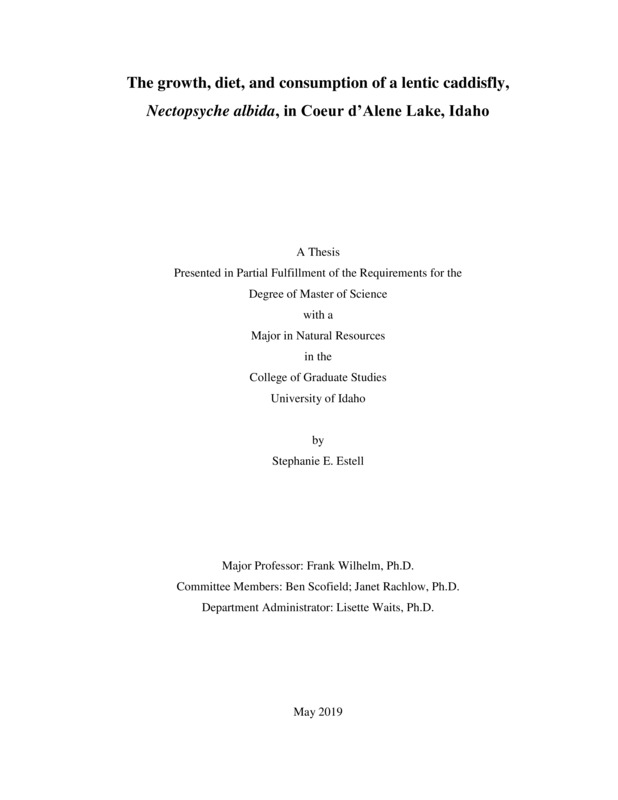The growth, diet, and consumption of a lentic caddisfly, Nectopsyche albida, in Coeur d’Alene Lake, Idaho
Estell, Stephanie. (2019-05). The growth, diet, and consumption of a lentic caddisfly, Nectopsyche albida, in Coeur d’Alene Lake, Idaho. Theses and Dissertations Collection, University of Idaho Library Digital Collections. https://www.lib.uidaho.edu/digital/etd/items/estell_idaho_0089n_11576.html
- Title:
- The growth, diet, and consumption of a lentic caddisfly, Nectopsyche albida, in Coeur d’Alene Lake, Idaho
- Author:
- Estell, Stephanie
- Date:
- 2019-05
- Embargo Remove Date:
- 2020-01-10
- Keywords:
- caddisfly Coeur d'Alene Lake diet invasive species macrophytes stable isotope
- Program:
- Natural Resources
- Subject Category:
- Natural resource management; Ecology; Entomology
- Abstract:
-
Understanding the role of an invasive species and its interactions with native species can be difficult. Invasive Eurasian milfoil has become established in the southern end of Coeur d’Alene Lake, also known as Chatcolet Lake, Idaho, and has become a nuisance for lake managers and the public. Managers with the Coeur d’Alene Tribe observed herbivory damage to the milfoil and native macrophyte species, but the cause was unknown. Nectopsyche albida larva, a native caddisfly, has been observed concurrently with herbivory. To uncover this possible connection, I examined three facets of its ecology; life history development, diet, and feeding rate and preference of N. albida larva. I collected samples in the summers of 2017 and 2018. Overall, the combined results reveal that caddisfly larva are univoltine, with adult emergence and a new generation hatching in mid-summer each year, though the exact timing is variable. The larva progress through five instars, and they consume mainly macrophytes. Their consumption is seemingly without species preference and the diet composition and feeding rate are dependent on season and life cycle development. The larva also use macrophytes to build their cases. It is highly likely that the caddisflies contribute to the observed herbivory damage of macrophytes. However, because N. albida larva do not appear to target any specific macrophyte species and the timing of their life-cycle poorly matches that of milfoil, they will unlikely be a significant component of management strategies for milfoil in Chatcolet Lake, Idaho.
- Description:
- masters, M.S., Natural Resources -- University of Idaho - College of Graduate Studies, 2019-05
- Major Professor:
- Wilhelm, Frank
- Committee:
- Scofield, Ben; Rachlow, Janet
- Defense Date:
- 2019-05
- Identifier:
- Estell_idaho_0089N_11576
- Type:
- Text
- Format Original:
- Format:
- application/pdf
- Rights:
- In Copyright - Educational Use Permitted. For more information, please contact University of Idaho Library Special Collections and Archives Department at libspec@uidaho.edu.
- Standardized Rights:
- http://rightsstatements.org/vocab/InC-EDU/1.0/

